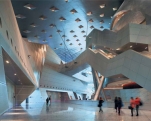Dalian International Conference Center: City Within a City

With the International Conference Center, the Vienne-based architectural studio Coop Himmelb(l)au has constructed an unmistakable landmark for the prospering harbour city of Dalian, China. Opened in 2013 and featuring a shell-shaped roof, the center hosts a multifunctional “small city within a city” with conference and event rooms for 7,000 visitors in a total area of 100,000 m².
The two major urban axes converging here give rise to the building’s position and basic shape. The conference hall for 2,500 visitors and opera house with 1,800 seats lie in the center of the building beneath the shell-shaped, partially translucent roof. Small conference rooms with numerous usage options surround this core like pearls, forming an internal urban structure with squares and streets that invite visitors to linger and chat – the informal meeting spaces that are so important for conferences. Chill-out zones and catering stations are also located here.
The controlled supply of daylight assists the visitors in their spatial orientation and creates a atmospheric variety on the inside. “Despite its enormous size for 7,000 people, the building is as vibrant as a city,” explains Wolf D. Prix, Design Principal and CEO of Coop Himmelb(l)au. “The entry hall has the size of four football fields and reaches up to 45 meters high. Even with this size, the building is not forbidding but rather clearly arranged and inviting.”
Form and function
It was determined from the outset that the World Economic Forum would be its main user. This Swiss foundation is mainly known for its annual meetings in Davos and annually organizes a “summer Davos” at this new site in China. The requirements for this function determined the spatial concept, the size and number of conference rooms and offices.
Since the opera and conference center lie directly behind one another, the main stage can be used for the classic theater auditorium just as well as for the flexible multipurpose hall. The opera house is based on a multifunctional design and can be used for such events as conferences, music and theatre all the way to classic opera with very little effort.
To make the building’s architectural concept and function visible from the outside, the conference halls penetrate the facade. They stand out against the metallic outer skin and deform it. The perforated aluminum slats of the exterior shell provide a sufficient amount of daylight and give the building its striking sculptural shape. The slats are opened in some of the public areas, offering selective views of the city and the bay of Dalian.
Full content of this issue you can read here
The full version of the article can be read in our printed issue, also you can subscribe to the web-version of the magazine
 Materials provided by Coop Himmelb(l)au
Materials provided by Coop Himmelb(l)au


